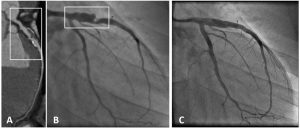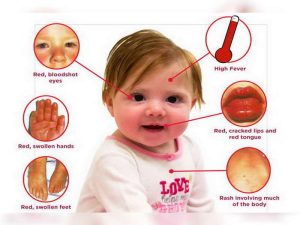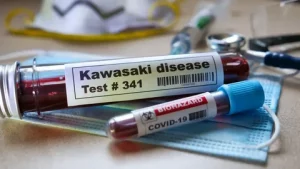- 29 January 2024
- 129
Beyond the Fever: Learning about Signs and Treatments for Kawasaki Disease

Introduction:
Kawasaki Disease, an uncommon but significant health concern, primarily targets young children, triggering inflammation within their blood vessels. This comprehensive guide aims to equip parents with a deeper understanding of this ailment, emphasizing the importance of early recognition, timely intervention, and continuous monitoring.
Causes and Risk Factors:
This enigmatic disease has the potential to inflict damage on coronary arteries, impacting the heart’s crucial function. Beyond cardiac implications, inflammation may extend to lymph nodes, skin, and the mucous membranes of the mouth, nose, and throat. Despite ongoing research, the precise cause remains elusive. Factors such as genetic predisposition, viral infections, and environmental elements, including chemicals and irritants, are under scrutiny.

While Kawasaki Disease is not considered contagious, sporadic clusters have been observed within communities. The prevalence tends to spike during the winter and spring months. Several risk factors heighten the likelihood of a child developing the disease, encompassing age (typically affecting those aged 5 or younger), gender (boys being more susceptible than girls), and ethnicity (with a higher incidence in children of Asian and Pacific Island descent).
Symptoms and Phases:
Understanding the progression of symptoms in distinct phases is vital for both parents and healthcare professionals.
- First Phase:
- A persistent high fever, often exceeding 101°F, lasting more than five days.
- A characteristic rash, frequently appearing between the chest and legs and in the genital or groin area.
- Peeling skin on the fingers and toes, typically manifesting in the second or third week of the illness.
- Swelling and redness in the hands and bottoms of the feet.
- Additional signs include red eyes, swollen glands, an irritated throat, and a distinctive “strawberry tongue.”
- Second Phase:
- Joint pain.
- Abdominal discomfort, often accompanied by issues such as diarrhea and vomiting.
- Continued peeling of the skin on the hands and feet.
- Potential onset of heart issues, typically occurring 10 days to 2 weeks after the initiation of symptoms.
- Third Phase:
- Gradual resolution of symptoms, with the entire phase lasting up to eight weeks.

Diagnosis:
Diagnostic procedures play a pivotal role in confirming Kawasaki Disease.
- A thorough physical examination and detailed inquiry into the child’s symptoms.
- Recognition of at least four out of five key signs: red eyes, dry and cracked lips, rash, swollen lymph nodes, and discolored skin on the palms and soles.
- Additional tests, including electrocardiogram (EKG), echocardiogram, blood tests, and imaging, may be employed to rule out other potential illnesses or assess the impact on the heart.

Treatment:
Addressing Kawasaki Disease necessitates a multi-faceted approach, often beginning with hospitalization for close monitoring.
- Medications such as aspirin and anticoagulants may be prescribed to alleviate pain and prevent blood clots.
- Intravenous immunoglobulin, a treatment involving antibodies to combat infection, is administered early in the course of the illness to mitigate the risk of heart complications.
- Low-dose aspirin may be continued for an extended period, particularly if there is an enlargement of the coronary artery (coronary artery aneurysm).
Regular follow-up visits and ongoing monitoring of heart health remain integral components of the treatment plan.

Complications:
While the majority of children recover completely, a small percentage may experience rare and potentially serious complications.
- Unusual heart rhythms (dysrhythmia).
- Inflamed heart muscles (myocarditis).
- Damaged heart valves (mitral regurgitation).
- Inflamed blood vessels (vasculitis).
- Aneurysms, characterized by weak or bulging artery walls, may arise, increasing the risk of arterial blockages, internal bleeding, and heart attacks.
In severe cases, surgical intervention may be necessary. Treatment for other health problems Infants, in particular, face a heightened risk of developing other serious health problems. It is noteworthy that the mortality rate during the early stages of the illness is extremely low, with fewer than 1% of children succumbing to Kawasaki Disease in the United States.

Outlook:
The prognosis for Kawasaki Disease, with prompt and appropriate treatment, is generally favorable. Most children can avoid long-term heart issues or fatalities. Notably, only 6% of treated children develop coronary artery aneurysms, and 50% of those with coronary artery problems experience healing within one or two years with proper treatment.
Conclusion:
In conclusion, Kawasaki Disease presents a challenging yet manageable health condition for children. The comprehensive understanding of its causes, symptoms, diagnosis, and treatment options is paramount for parents. Early detection and intervention significantly improve the overall outlook, allowing children to overcome the disease without lasting health complications. Continuous collaboration with healthcare professionals, adherence to treatment plans, and vigilant monitoring contribute to a positive prognosis, ensuring the well-being of children affected by Kawasaki Disease.

